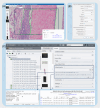Setting up an institutional OMERO environment for bioimage data: Perspectives from both facility staff and users
- PMID: 39275979
- PMCID: PMC11629930
- DOI: 10.1111/jmi.13360
Setting up an institutional OMERO environment for bioimage data: Perspectives from both facility staff and users
Abstract
Modern bioimaging core facilities at research institutions are essential for managing and maintaining high-end instruments, providing training and support for researchers in experimental design, image acquisition and data analysis. An important task for these facilities is the professional management of complex multidimensional bioimaging data, which are often produced in large quantity and very different file formats. This article details the process that led to successfully implementing the OME Remote Objects system (OMERO) for bioimage-specific research data management (RDM) at the Core Facility Cellular Imaging (CFCI) at the Technische Universität Dresden (TU Dresden). Ensuring compliance with the FAIR (findable, accessible, interoperable, reusable) principles, we outline here the challenges that we faced in adapting data handling and storage to a new RDM system. These challenges included the introduction of a standardised group-specific naming convention, metadata curation with tagging and Key-Value pairs, and integration of existing image processing workflows. By sharing our experiences, this article aims to provide insights and recommendations for both individual researchers and educational institutions intending to implement OMERO as a management system for bioimaging data. We showcase how tailored decisions and structured approaches lead to successful outcomes in RDM practices. Lay description: Modern bioimaging facilities at research institutions are crucial for managing advanced equipment and supporting scientists in their research. These facilities help with designing experiments, capturing images, and analyzing data. One of their key tasks is organizing and managing large amounts of complex image data, which often comes in various file formats and are difficult to handle. This article explains how the Core Facility Cellular Imaging (CFCI) at Technische Universität Dresden successfully implemented a specialized system called OMERO. With this system it is possible to manage and organize bioimaging data sustainably in a way that they are findable, accessible, interoperable and reusable according the FAIR principles. We describe the practical implementation process on exemplary projects within scientific research and medical education. We discuss the challenges we faced, such as creating a standard way to name files, organizing important information about the images (known as metadata), and ensuring that existing image processing methods could work with the new system. By sharing our experience, we aim to offer practical advice and recommendations for other researchers and institutions interested in using OMERO for managing their bioimaging data. We highlight how careful planning and structured approaches can lead to successful data management practices, making it easier for researchers to store, access, and reuse their valuable data.
Keywords: FAIR principles; OMERO; bioimaging data; imaging facility; research data management (RDM).
© 2024 The Author(s). Journal of Microscopy published by John Wiley & Sons Ltd on behalf of Royal Microscopical Society.
Figures




Similar articles
-
Research data management for bioimaging: the 2021 NFDI4BIOIMAGE community survey.F1000Res. 2022 Jun 10;11:638. doi: 10.12688/f1000research.121714.2. eCollection 2022. F1000Res. 2022. PMID: 36405555 Free PMC article.
-
A practical guide to bioimaging research data management in core facilities.J Microsc. 2024 Jun;294(3):350-371. doi: 10.1111/jmi.13317. Epub 2024 May 16. J Microsc. 2024. PMID: 38752662 Review.
-
BIOMERO: A scalable and extensible image analysis framework.Patterns (N Y). 2024 Jul 18;5(8):101024. doi: 10.1016/j.patter.2024.101024. eCollection 2024 Aug 9. Patterns (N Y). 2024. PMID: 39233696 Free PMC article.
-
Setting up a data management infrastructure for bioimaging.Biol Chem. 2023 Mar 1;404(5):433-439. doi: 10.1515/hsz-2022-0304. Print 2023 Apr 25. Biol Chem. 2023. PMID: 36853922
-
Initiatives, Concepts, and Implementation Practices of the Findable, Accessible, Interoperable, and Reusable Data Principles in Health Data Stewardship: Scoping Review.J Med Internet Res. 2023 Aug 28;25:e45013. doi: 10.2196/45013. J Med Internet Res. 2023. PMID: 37639292 Free PMC article.
References
-
- Ferrando‐May, E. , Hartmann, H. , Reymann, J. , Ansari, N. , Utz, N. , Fried, H. U. , Kukat, C. , Peychl, J. , Liebig, C. , Terjung, S. , Laketa, V. , Sporbert, A. , Weidtkamp‐Peters, S. , Schauss, A. , Zuschratter, W. , & Avilov, S. (2016). Advanced light microscopy core facilities: Balancing service, science and career. Microscopy Research and Technique, 79, 463–479. 10.1002/jemt.22648 - DOI - PMC - PubMed
-
- Anderson, K. I. , Sanderson, J. , & Peychl, J. (2007). Design and function of a light‐microscopy facility. In Shorte S. L., & Frischknecht F. (Eds.), Imaging cellular and molecular biological functions (pp. 93–113). Springer Berlin Heidelberg. 10.1007/978-3-540-71331-9_4 - DOI
-
- Kemmer, I. , Keppler, A. , Serrano‐Solano, B. , Rybina, A. , Özdemir, B. , Bischof, J. , El Ghadraoui, A. , Eriksson, J. E. , & Mathur, A. (2023). Building a FAIR image data ecosystem for microscopy communities. Histochemistry and Cell Biology, 160, 199–209. 10.1007/s00418-023-02203-7 - DOI - PMC - PubMed
MeSH terms
Grants and funding
LinkOut - more resources
Full Text Sources

